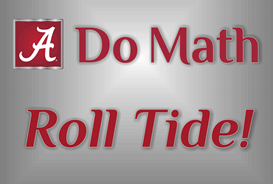35th Annual High School Math Tournament
Math Technology Learning Center 411 Hackberry Lane, Tuscaloosa, AL, United StatesAnalysis Seminar – Jaedeok Kim (Jacksonville State)
227 Gordon Palmer Hall 505 Hackberry Lane, Tuscaloosa, AL, United StatesAbstract: A classification of partial isometries defined on a Hilbert space can be made in terms of positions that two subspaces, the initial space and the final space, form. When the orthogonal projections onto two subspaces commute, any power of the partial isometry remains also a partial isometry. This type of partial isometry is called
Algebra/Topology Seminar – Sergio Fabi, UA Department of Physics
228 Gordon Palmer Hall Tuscaloosa, AL, United StatesTitle: Lie Groupoid Abstract: Motivation and introduction to the general theory of groupoid, Lie groupoid and Lie algebroid. Few examples are given, in particular the gauge groupoid.
Analysis Seminar – Carlos Pérez (University of the Basque Country and Ikerbasque, Spain)
302 Gordon Palmer HallTitle: Rough Singular Integrals: A1 theory Abstract: In this mostly expository talk we will discuss new results for rough Singular Integral Operators involving A1 weights. These are convolution operators whose kernels do not satisfy the standard regularity conditions (Lipschitz or Dini). Being more precise we will discuss estimates for these operators in the context of
Algebra/Topology Seminar – Sergio Fabi, University of Alabama Department of Physics
228 Gordon Palmer Hall Tuscaloosa, AL, United StatesTitle: Atiyah sequence Abstract: Review of the theory of exact sequences to define a connection on a principal bundle. The construction of a gauge theory of gravity on a Lie algebroid is considered.
Last Math Undergrad Tea of the Semester and Putnam Exam Pep Rally
302 Gordon Palmer HallOn Saturday, December 3, the UA Putnam team will compete in the 77th annual Putnam Exam. Come to tea, cheer on the team and celebrate the end of the semester. There will be special refreshments and a visit by Big Al!
Analysis Seminar – Geoff Diestel, Texas A&M of Central Texas
227 Gordon Palmer Hall 505 Hackberry Lane, Tuscaloosa, AL, United StatesTitle: Determining Convex Bodies from Central Sections Abstract: Barker and Larman posed a problem which asks if a convex body in real n-space is uniquely determined by the volumes of its hyperplane sections supported by an internal compact convex set. A survey of some partial results along with the Minkowski uniqueness theorem are presented along
Undergraduate Math Tea
302 Gordon Palmer HallSeminar – Hristo Sendov, University of Western Ontario
228 Gordon Palmer Hall Tuscaloosa, AL, United StatesEvery Calculus student is familiar with the classical Rolle’s theorem stating that if a real polynomial p satisfies p(−1) = p(1), then it has a critical point in (−1, 1). In 1934, L. Tschakaloff strengthened this result by finding a minimal interval, contained in (−1, 1), that holds a critical point of every real polynomial
